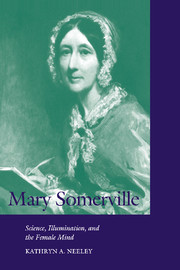Book contents
- Frontmatter
- Contents
- Author's Preface
- Key to Parenthetical References to the Works of Mary Somerville
- Prologue: Perceiving What Others Do Not Perceive: The “Peculiar Illumination” of the Female Mind
- 1 Head among the Stars, Feet Firm upon the Earth: The Problem of Categorizing Mary Somerville
- 2 Creating a Room of Her Own in the World of Science: How Mary Fairfax Became the Famous Mrs. Somerville
- 3 Science as Exact Calculation and Elevated Meditation: Mechanism of the Heavens (1831), “Preliminary Dissertation” (1832), and On the Connexion of the Physical Sciences (1834)
- 4 The Earth, the Sea, the Air, and Their Inhabitants: Physical Geography (1848) and On Molecular and Microscopic Science (1869)
- 5 Mary Somerville on Mary Somerville: Personal Recollections (1873)
- 6 Memory and Mary Somerville: In the Public Eye and Historical Memory
- Epilogue: Science, Voice, and Vision
- Selected Bibliography
- Index
Epilogue: Science, Voice, and Vision
Published online by Cambridge University Press: 30 March 2010
- Frontmatter
- Contents
- Author's Preface
- Key to Parenthetical References to the Works of Mary Somerville
- Prologue: Perceiving What Others Do Not Perceive: The “Peculiar Illumination” of the Female Mind
- 1 Head among the Stars, Feet Firm upon the Earth: The Problem of Categorizing Mary Somerville
- 2 Creating a Room of Her Own in the World of Science: How Mary Fairfax Became the Famous Mrs. Somerville
- 3 Science as Exact Calculation and Elevated Meditation: Mechanism of the Heavens (1831), “Preliminary Dissertation” (1832), and On the Connexion of the Physical Sciences (1834)
- 4 The Earth, the Sea, the Air, and Their Inhabitants: Physical Geography (1848) and On Molecular and Microscopic Science (1869)
- 5 Mary Somerville on Mary Somerville: Personal Recollections (1873)
- 6 Memory and Mary Somerville: In the Public Eye and Historical Memory
- Epilogue: Science, Voice, and Vision
- Selected Bibliography
- Index
Summary
Gravitation … connects sun with sun throughout the wide extent of creation … every tremor it excites in any one planet is immediately transmitted to the farthest limits of the system … like sympathetic notes in music, or vibrations from the deep tones of an organ.
–Mary Somerville, On the Connexion of the Physical SciencesWhat Mary Somerville was and what she accomplished are captured in the self-portrait that serves as the frontispiece for this book. One of the most striking characteristics of the self-portrait is the directness with which the subject meets the gaze of the viewer. She deliberately presented herself as an author, pen in hand and seemingly in the midst of composition. Her clothing seems decidedly, perhaps even selfconsciously, feminine. The face is portrayed with much more accuracy and detail than any other part of the portrait except for her hands. In fact, much of the background is treated in an impressionistic way that almost suggests that the portrait is not yet finished. For the style of portraiture of the time, the gaze is uncommonly direct. It is neither reluctant nor aggressive, but, rather, discerning, perspicacious, shrewd.
In one respect, the directness of the gaze reflects her voice as an author, the hard-won confidence and authority that Somerville enjoyed as a scientist and an intellectual. Her life story demonstrates what a great distance had to be traversed in order for her – or for any woman of her time – to overcome the norms of deference that she surmounted in meeting the viewer's gaze so directly.
- Type
- Chapter
- Information
- Mary SomervilleScience, Illumination, and the Female Mind, pp. 238 - 240Publisher: Cambridge University PressPrint publication year: 2001

